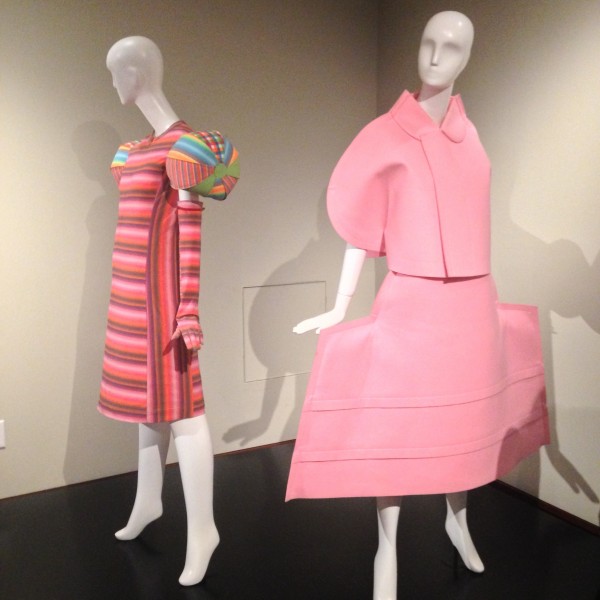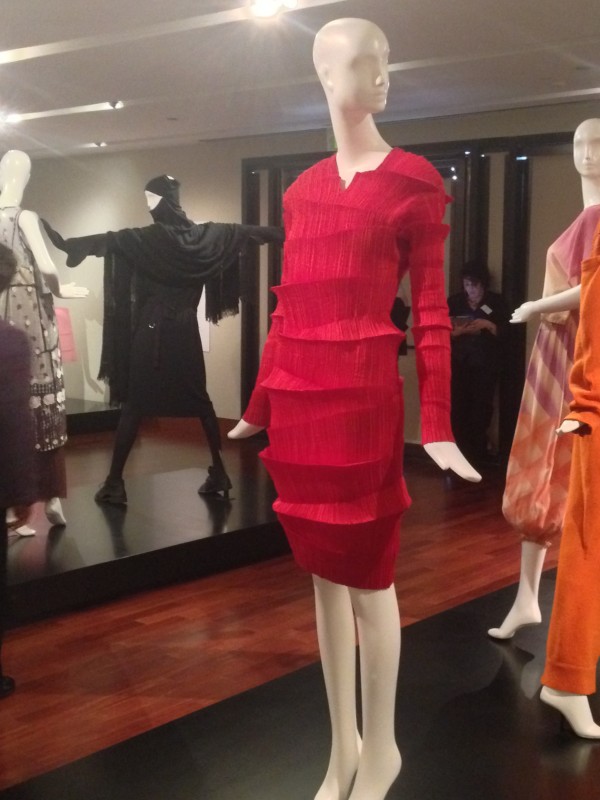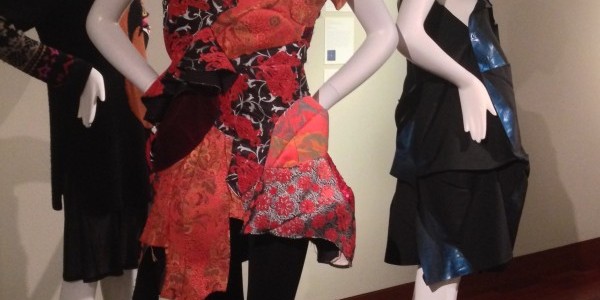Two exhibitions have brought Japanese art to the city of Dallas. It is a welcome change from shows like the staid flower paintings of Bouquets at the Dallas Museum of Art (DMA).
These two exhibitions, one at DMA (Between Action and the Unknown: The Art of Kazuo Shiraga and Sadamasa Motonaga) joined The Mary Baskett Collection of Japanese Fashion, a display at the Crow Collection across the street (ended Feb 22). With an eye on postwar Japan, the exhibits almost (and perhaps accidentally) were compliments to each other.
They are both dark, edgy and provocative. For Anime fans or someone in love with Japanese pop, they reveal the culture of a people. Even in their most colorful fantasies, there exists a repeating underlying theme of turmoil and destruction.
The Japanese fashion exhibit at the Crow Collection features a dozen examples from three artists. To me, modern fashion has become fleeting hype in American art institutions ever since the blockbuster Alexander McQueen show at the MET (the DMA website currently exclaims “Forget Fashion Week—It’s Fashion Season at the DMA”). Maybe curators see it as a viable channel to engage with a younger audience. But the Met’s success may be hard to repeat.
There is no magic formula to strike the right balance between overly commercial, utilitarian and extravagant while maintaining a scholarly rigidity. But the intimate space at the Crow Collection means it is not so jam-packed to overload your brain. And the fact that these are the very clothes which Mary Baskett, the curator at the Cincinnati Art Museum, wears daily, make them personal and approachable.
The emphasis on the process and the material is no more a new notion in modern art. For Miyake, Yamamoto, and Kawakubo, the two unite into one tangible aspect of their aesthetics.

Front: Rei Kawakubo, Broken Bride Dress (polyester) 2005
Those aesthetics were new back then. The couture culture of the late 60’s and 70’s was reigned over by Europeans with their focus on cut, fit, and proportion. To them, the rise of Japanese fashion vocabulary must be shocking.
The tattered, rough-edged and drapery effects are deeply rooted in Japanese culture. Wabi-sabi finds beauty in the impermanent, imperfect and incomplete. This is more pronounced in one of Rei Kawakubo’s designs. The asymmetric dress from her 2009 collection looks like a collage painting wrapped around a model. Harmonized in a warm orange tone, different patches are sewn or overlayed together, leaving curvilinear seems an integral part of a floral theme. Some dark patterns roll into concave forms. They echo more to spatial than the bodily relationship.
The dress is labeled as cotton, rayon, polyester, polyurethane, and acrylic. It would be interesting to have a picture of Ms. Baskett wearing it at work.
Yohji Yamamoto has functionality more in mind. At least I would probably wear them had they been made for men. (I guess I could choose Rick Owen collection if I dare.) They would look more favorable if a collection of his, mostly dark on dark over layers, are displayed on their own. Or better, with real models moving around the T stage, where movement accentuates the sensual shadows over pale skin.
Issey Miyake is the oldest of the trio (all in their 70’s). Miyake was trained in Paris and New York in the 1960’s. It is interesting that he maintains “fashion is not art” while treating his collection as an embodiment of sculpture in fabric fitting in human contour. Dress and gloves from his 2000 collection feature horizontal stripes in neon colors, extending to each finger nail. The sculpted round shoulder pads, probably inspired by military epaulets with tassels, catch all the attention with their vertical stripes to compete for the rest of the patterns. I would imagine the oversized shoulder treatment would exaggerate with an arm swing in real life. Is this because female sexuality is too overbearing in stripes that it must be toned down with mechanical strides?

It is hard to understand his innovation in textile (like how to enable knit fabric to be cut) by looking at those dresses. For example, one dress from 132_5 series is made from recycled polyester. Nevertheless, Miyake’s design is hands down for its wearability. It has a subdued midnight blue sheen from folded angular fabric. The directional tilting in the folds and its asymmetric cut give the dress both power and energy. It would make a perfect evening dress in Frank Gehry’s Walt Disney Music Hall.
The majority of Baskett’s collection shown in the current exhibition are made from the last two decades. It would be more interesting to compare them with those released in the early 70’s when they were a true cultural shock. In case that you need to pursue her path and want to own a piece of Issey Miyake, rest assured, that doesn’t have to break your bank account.
Like the Alexander McQueen brand, which still produces ready-to-wear clothing after McQueen’s death, these artists have their commercial lines (with of course less eccentric products). You can find a dress by Miyake in major departmental stores, without going across the Pacific Ocean.
Discover more from Urban Art & Antiques
Subscribe to get the latest posts sent to your email.


